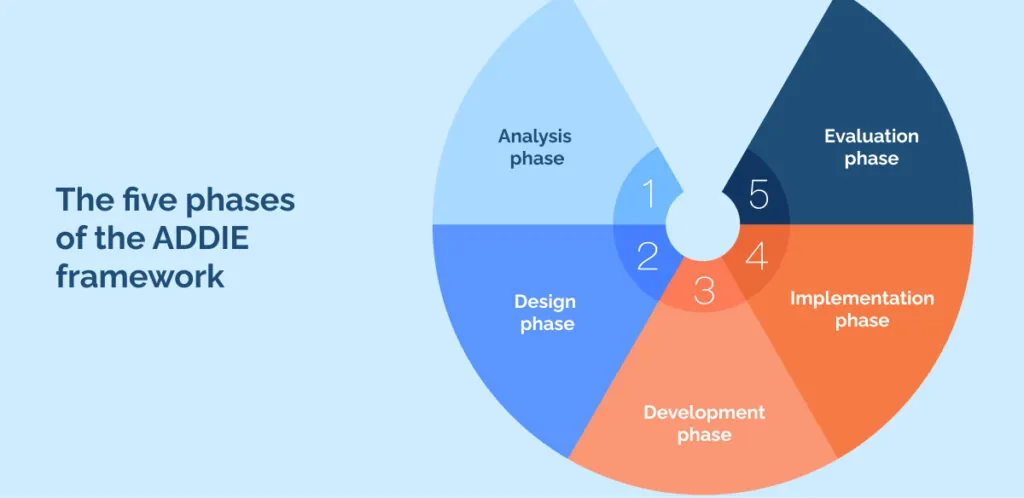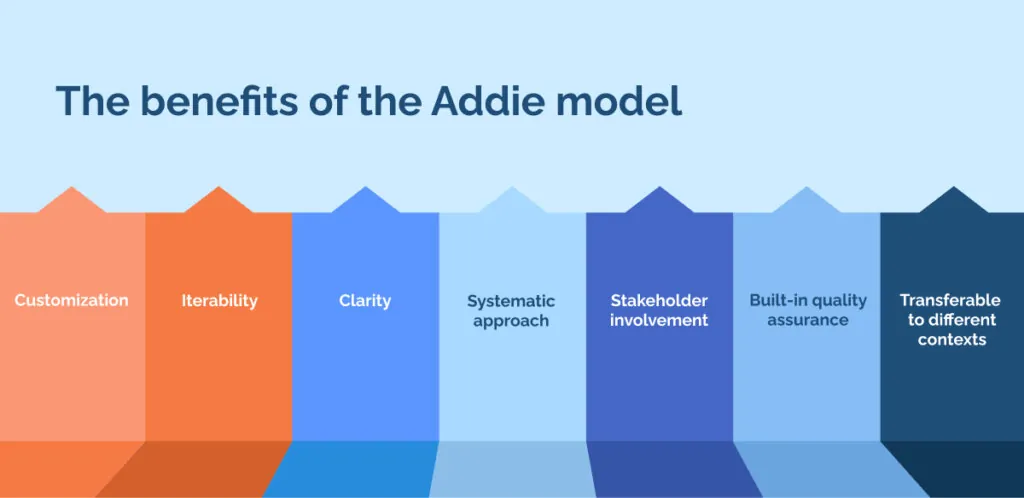
In the world of instructional design, so much has changed in the past two decades. Technological trends have been one of the most visible changes. But at an organizational level, training now has a very close link to core business outcomes.
However, you can still use tried-and-tested tools to navigate these new difficulties. The ADDIE model of instructional development is one of those tools. The fundamentals of learning have stayed the same, and ADDIE helps us to remember how to make development programs that really work.
This article will explore the following topics related to the ADDIE model:
- What is the ADDIE model?
- The five components of the ADDIE model
- The benefits and downsides of the ADDIE model
- Alternatives for the ADDIE process for your educational and training programs
If you’re developing a course curriculum, training developers, or seeking to become a learning organization, it’s vital to reach for a strategic approach.
What is the ADDIE model?
The ADDIE model is a systematic instructional design framework used to guide the process of creating educational and training programs.
The acronym “ADDIE” stands for the five phases of the framework:
- Analysis
- Design
- Development
- Implementation
- Evaluation.
Initially, it identifies learning objectives and learner needs (Analysis), then outlines instructional strategies (Design), followed by creating educational materials (Development). It proceeds to deliver these materials to the audience (Implementation) and concludes with assessing the program’s effectiveness (Evaluation).
This iterative approach is favored in educational technology and corporate training in the U.S. because of its adaptability and comprehensive structure.
Why is the ADDIE model useful?
Instructional designers use ADDIE to make their training provide the best answers to real needs, leading to well-planned, learner-centric outcomes. This model helps identify learning needs, design tailored solutions, and evaluate the effectiveness of the instructional program, ultimately enhancing the overall quality of education and training initiatives.
People have different stories about the origins of the “ADDIE model”. For example, many point to an ADDIE-style model in Branson’s Interservice Procedures for Instructional Systems Development from 1975. However, as Michael Molenda showed in a crucial essay from 2003, no major author has ever set out to explain an “ADDIE model”. Furthermore, even discipline-leading books on instructional design seldom refer directly to the ADDIE model.
However, ADDIE is in active use in many areas: including government, healthcare, and business organizations. If nothing else, it is a great way to remind planners what they need to do – and in what order.
The five phases of the ADDIE framework

The five phases of the ADDIE Framework, each playing a crucial role in instructional design, are:
Analysis phase
The purpose of the “analysis” stage is to create the foundations for the entire instructional design process. It ensures that subsequent phases are informed, targeted, and aligned with the identified needs and goals. A good analysis will vary, but it will likely include various tasks, including:
- Needs Assessment and Training Development. Here, the focus is on recognizing performance gaps through a needs assessment, which serves as a pivotal step in understanding the disparity between current and required skills. The process involves aligning assessment goals with the program’s overarching objectives and engaging stakeholders for a collaborative approach.
- Data Collection and Analysis. The emphasis here is on gathering comprehensive information by utilizing existing data, conducting environmental scans, and employing suitable methods such as interviews or surveys. The analysis phase zeroes in on specific gaps in knowledge, skills, or behavior, considering both individual and systemic factors.
- Training Needs Analysis. This step involves a detailed examination to identify the “who,” “what,” “when,” and “where” of the training audience. Critical competencies, learner characteristics, and preferences are assessed to tailor the training approach to specific needs and optimize effectiveness.
- Strategic Review and Interpretation. Collaboration with partners is crucial during the review and interpretation phase. Findings are carefully assessed, considering diverse learner needs and settings. Prioritization of training solutions is based on long-term organizational goals and the availability of resources.
Design phase
The “Design” stage of the ADDIE model involves creating a detailed plan for the instructional materials and learning activities based on the analysis conducted in the previous stage.
During this phase, instructional designers outline the structure and organization of the training program, develop specific learning objectives, and choose appropriate instructional strategies.
Designers also focus on creating engaging content, selecting relevant media, and determining the best methods to deliver the training. The goal is to ensure that the training aligns with the identified needs and objectives while catering to the characteristics and preferences of the target audience.
Development phase
In the development phase, the plans from the design phase come to life. This dynamic stage involves the hands-on creation of various learning materials and content, including presentations, course materials, e-learning modules, assessments, and other resources.
Collaboration is a key theme during this stage, often involving specialists from different fields. Writers, multimedia experts, graphic designers, and other professionals contribute their expertise to create a cohesive and engaging learning experience. This collaborative effort facilitates an iterative process, allowing for ongoing revisions and improvements based on feedback received.
The ultimate goal of the Development phase is to produce finalized learning materials. These materials undergo rigorous evaluation and refinement to ensure they align with the established learning objectives and instructional design principles. This active and collaborative approach sets the stage for the finalization of materials ready for implementation in the next phases of the ADDIE model.
Implementation phase
In the implementation phase, instructors put the learning materials into action. This stage involves the actual deployment of the training or educational program to the target audience. Trainers or instructors deliver the content, and learners engage with the materials and activities.
During implementation, it is crucial to monitor and manage the learning process. This includes addressing any unexpected challenges, providing support to learners, and ensuring that the instructional materials function as intended. Feedback from both learners and instructors is collected to inform any necessary adjustments.
Effective communication is key during this phase to ensure a smooth rollout of the instructional program. The Implementation stage sets the foundation for the final phase of the ADDIE model, Evaluation, where the overall effectiveness of the instruction is assessed based on defined criteria and feedback from stakeholders.
Evaluation phase
The evaluation phase in the ADDIE model is the final step, serving as a crucial feedback loop for training improvement.
Collaboration with stakeholders is key to defining the purpose, whether it’s enhancing current programs, developing new ones, or making resource allocation decisions. The evaluation of the process is guided by key evaluation questions. Selection of appropriate data collection methods, considering feasibility and resources, completes the phase, providing valuable insights for informed decision-making and ongoing refinement of training initiatives.
The benefits of the Addie model

ADDIE process is a wide-ranging and popular model, which consistently helps trainees reach their learning outcomes. In this section, we’ll take a look at some of the key benefits that have made it so enduring.
Customization
The ADDIE model stands out for its adaptability, effortlessly tailoring itself to diverse learning needs. Whether deployed in various industries, disciplines, or for individual and group learning, this flexibility ensures a customized approach that aligns with the unique characteristics of both the audience and subject matter.
Iterability
A core strength of the ADDIE model lies in its emphasis on iteration. Throughout each stage of development, the model encourages ongoing feedback and adjustments, fostering continuous improvement. This iterative approach ensures prompt incorporation of necessary modifications, leading to the refinement of instructional content throughout the entire design process.
Clarity
The ADDIE model offers clear and well-defined guidelines for every phase of instructional design. This clarity gives structured guidance for instructional designers, educators, and stakeholders through the entire process. With distinct stages and objectives, the model facilitates an efficient approach to creating effective learning experiences.
Systematic approach
Known for its systematic nature, the ADDIE model provides a structured approach to training development. This systematic methodology ensures precision at each step, contributing to overall efficiency and consistency in the quality of course development. The ordered sequence minimizes the risk of overlooking crucial elements in the instructional design process.
Stakeholder involvement
The ADDIE model gives lots of places for stakeholders to have their say in the planning process. Encouraging collaboration from initial analysis to final evaluation, the model ensures that the perspectives and expertise of various stakeholders are considered. This involvement enhances the relevance and effectiveness of the training content.
Built-in quality assurance
Through systematic evaluation at each stage, the model enables the identification of strengths and weaknesses in learning materials. This ongoing assessment contributes to content refinement, ensuring the final product meets desired learning objectives and maintains high standards.
Transferable to different contexts
The versatility of the ADDIE model is evident in its transferability across diverse educational and training contexts. Whether applied in academic settings, corporate training programs, or other learning environments, the model’s principles remain relevant. Its adaptability allows for seamless integration into different contexts, making it a widely applicable framework for instructional design.
Two alternatives to the ADDIE models
Before we finish, this section will reflect on some of the alternative planning options. A positive learning environment can take shape in different ways. If ADDIE does not seem to fit you perfectly, see whether these other options can help.
McKinsey’s ACADEMIES framework
The McKinsey ACADEMIES framework focuses squarely on teaching and learning in a business context. The ADDIE training model can flourish in any system: but ACADEMIES looks at business from the very beginning.
Authors from McKinsey explained in 2019 that the model works in 9 parts:
- Alignment with business strategy
- Co-ownership between business units and HR
- Assessment of capability gaps and estimated value
- Design of learning journeys
- Execution and scale-up
- Measurement of impact on business performance
- Integration of L&D interventions into HR processes
- Enabling of the 70:20:10 learning framework
- Systems and learning technology applications
These steps will support strategic alignment with business goals, improved collaboration between business units and HR, and systematic identification and closure of capability gaps. These benefits collectively contribute to a dynamic and adaptive learning system that fosters organizational growth and success.
Systems model approach (Dick and Carey)
Walter Dick and Lou Carey’s approach is a systematic and comprehensive model for designing effective instructional programs. The model consists of ten stages:
- Identify instructional goals
- Conduct instructional analysis
- Define entry behaviors and prerequisites
- Write performance objectives
- Develop assessment instruments
- Develop instructional strategy
- Develop and select materials
- Design and conduct formative evaluation
- Revise instruction
- Develop and conduct a summative evaluation
The Dick and Carey Model emphasizes a systematic, learner-centered approach to instructional design, with a focus on clearly defined objectives, continuous evaluation, and refinement of the instructional materials and methods.
ADDIE in the digital world
As we’ve argued throughout this article, high-level models like ADDIE continue to be useful in 2024. Learning and development trends come and go. But the fundamental aspects of planning are just the same as ever. Models like ADDIE are great – they keep us rooted in the past, and the fundamental value of teaching and learning.At a moment where learning and development outcomes should be “key in realizing business strategy”, as the 2022 E&Y analysis argues, ADDIE still gives you a tool to stand back and evaluate how to make the most significant impact on your organization.
WalkMe Team
WalkMe spearheaded the Digital Adoption Platform (DAP) for associations to use the maximum capacity of their advanced resources. Utilizing man-made consciousness, AI, and context-oriented direction, WalkMe adds a powerful UI layer to raise the computerized proficiency, everything being equal.



